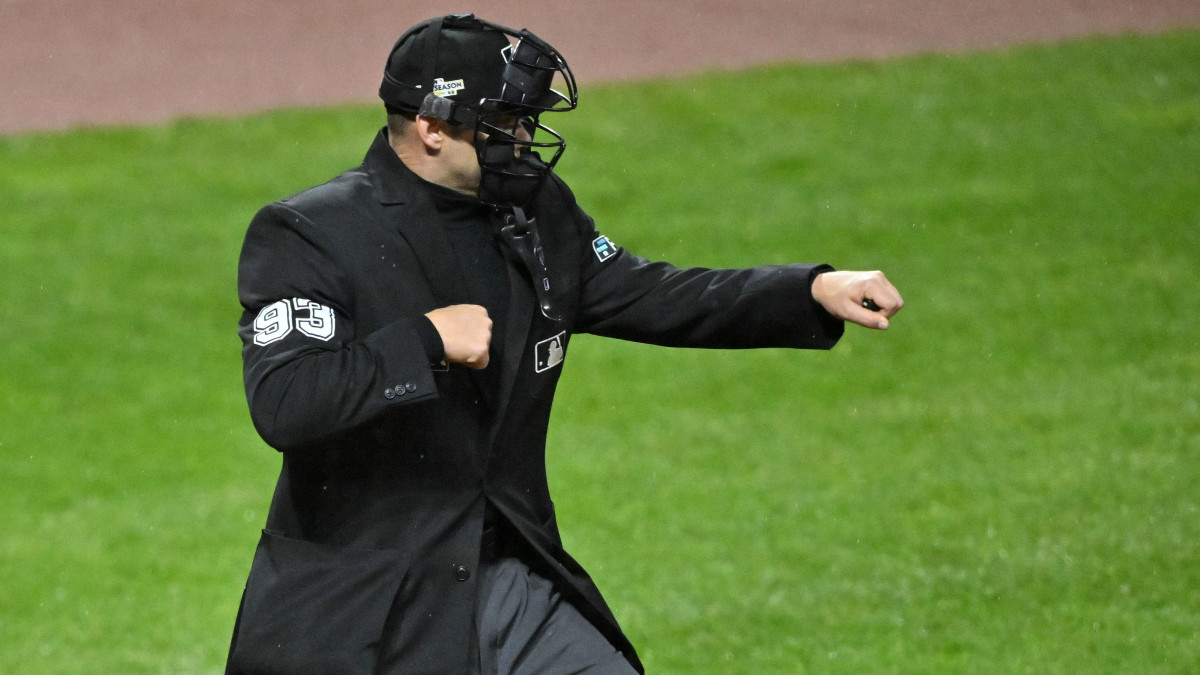How MLB Umpires’ New Hand Signal Came to Be
It’s a big spring for MLB umpires.
As the game invites seismic change, umpires are the ones tasked with handling a slew of new rules, from a ban on infield shifts to a refined definition of a balk. There’s been plenty said about how to interpret and enforce these rules. But one more thing: How will umpires signal them?
Maybe that sounds unimportant. But how a decision is communicated on the field matters—everyone needs to understand what’s happened simply and clearly, even fielders at a distance and fans in the stands. Think of how straightforward the existing signals are. There are the outstretched arms of “safe” and the simple, declarative fist of “out.” There’s the whirligig motion to signal a home run, reminiscent of a runner going around the bases, and the simple finger arithmetic that indicates the count. If anyone didn’t already know what these signals meant—if they hadn’t all been around for decades—it would be easy to guess. Which is precisely the point.

But it’s been a long time since MLB has needed to figure out a new umpiring hand signal. So: What’s the process of deciding exactly what those apparent, straightforward motions should be? An ump commission? A focus group? A top-secret tribunal?
Not quite. The truth is far more tedious, says MLB vice president of on-field strategy Joe Martinez, a retired pitcher. They watched the minor league umpires who enforced variations of these rules as a test last year. And they followed their lead.
Many of the new rules either fit inside the existing framework or don’t require any specific signals for infractions. The big exception is the pitch timer: The clock is unlike anything else already in the game, and violations will generally be called by the home plate umpire, who already has the responsibility of calling balls and strikes. That means a brand-new signal is needed to communicate that someone has taken too long—something distinct, obvious and easily recognizable. The minor league umpires found a motion last year that felt natural. MLB liked it enough to implement it.
If a player takes too long this season, the ump will tap their wrist, as if tapping a watch, indicating time is up.
“We want them to be very demonstrative,” Martinez says. “There are going to be fans wondering what’s going on, right? So that kind of pointing … we want that to be very clear.”
There will be timers in each stadium visible behind home plate for the pitcher and in the outfield for the hitters. (While the home plate umpire will have jurisdiction over the clock—able to call for it to be paused for a disruption on the field or similar circumstance—a clock operator will handle the mechanics of running the system.) The timer will set a limit of 15 seconds between pitches with the bases empty and 20 seconds with runners on. There’s also a provision requiring that hitters be in the box at the eight-second mark. If the pitcher takes too long, he’ll be charged an automatic ball, and, if a hitter does so, he’ll be charged an automatic strike.
But Martinez and others in the MLB administration emphasized that they don’t expect many such violations. There will undoubtedly be a period of adjustment. But almost 90% of Triple A players—both pitchers and hitters—said they got accustomed to the timer within a month last year when surveyed by MLB. If the same holds true for major leaguers, expect to see players trying to make the adjustment in spring training and the early weeks of the season, and not so much thereafter.
“I think people don’t give players enough credit sometimes,” Martinez says. “They’re going to adjust. It’s not always easy, but they will.”
In other words: Fans shouldn’t expect to see the ump tapping his wrist too often as the season wears on. But when they do? It should be clear what it means.
